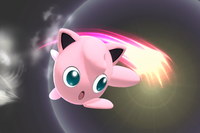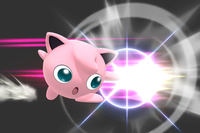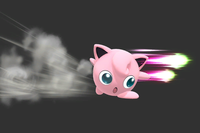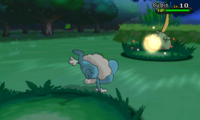Pound: Difference between revisions
Serpent King (talk | contribs) m (Serpent King moved page Pound (move) to Pound without leaving a redirect: Move without consensus) |
mNo edit summary |
||
| Line 1: | Line 1: | ||
{{ArticleIcons|ssb=y|ssbm=y|ssbb=y|ssb4=y}} | {{ArticleIcons|ssb=y|ssbm=y|ssbb=y|ssb4=y}} | ||
:''This is Jigglypuff's special move. For the tournament series, see [[Pound (disambiguation)]].'' | |||
{{Infobox Special Move | {{Infobox Special Move | ||
|name=Pound | |name=Pound | ||
Revision as of 07:54, January 28, 2016
- This is Jigglypuff's special move. For the tournament series, see Pound (disambiguation).
| Pound | |
|---|---|
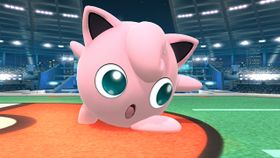 Pound being used in Super Smash Bros. for Wii U | |
| User | Jigglypuff |
| Universe | Pokémon |
| Article on Bulbapedia | Pound (move) |
| “ | Pound does serious damage, and it can also help as a recovery move. | ” |
| —Jigglypuff's trophy description in Melee | ||
| “ | Slap your opponents so hard they fly straight into the air. | ” |
| —Super Smash Bros. for Wii U's Quick Guide | ||
Pound (はたく, Strike) is Jigglypuff's neutral special move in Super Smash Bros. and side special move from Melee onward.
Overview
It is a short-range attack that sends Jigglypuff forward a short distance with its arm out in front of it to punch while exclaiming "Puff!". Pound is very useful when recovering, as it can be used between jumps to give Jigglypuff more horizontal distance. This technique is required to beat Jigglypuff's Board the Platforms in Super Smash Bros. In Smash 4, Pound has lost some of its horizontal distance, limiting its recovery abilities.
In the original, the move always launched opponents at a diagonal angle behind Jigglypuff. In Melee, Pound either knocks opponents vertically if used at a close range, or sends them at a slightly more horizontal angle than in the original game if it hits afterwards, while in Brawl, the angles are the opposite of Melee. The move does a maximum of 13% damage in the original and Melee, and 11% in Brawl and Smash 4.
Although Pound is mostly used for recovery and movement purposes, it can also be utilized as an effective attack. While it comes out a bit slow, Pound has a hitbox that stays out longer than one might expect, causing opponents to drop their guard too early at times, and in cases where opponents do shield the attack it will take an extra 20 shield damage. In Smash 4, Pound significantly benefits from the removal of damage reduction on shields, allowing the high shield damage hitbox to bring shields to a near sliver of health. In certain situations, Pound can also serve as a set-up for Jigglypuff's powerful Rest attack.
Changes across games / versions
SSB to Melee
 Given a new trajectory which improves combo ability.
Given a new trajectory which improves combo ability. Rising Pound technique is easier to perform.
Rising Pound technique is easier to perform. Input: Neutral special → Side Special
Input: Neutral special → Side Special
Melee to Brawl
 Now does more vertical knockback.
Now does more vertical knockback.
Brawl to Smash 4
 Deals more shield damage due to the removal of damage reduction on shields.
Deals more shield damage due to the removal of damage reduction on shields. Hitbox lasts for a longer period of time.
Hitbox lasts for a longer period of time. Momentum reduced, limiting recovery ability.
Momentum reduced, limiting recovery ability.
 Allows the attack to block most projectiles because of this, however.
Allows the attack to block most projectiles because of this, however.
Rising Pound
As pressing up quickly after using Pound causes Jigglypuff to gain height, and the move does not put it into helpless state, Pound gives Jigglypuff a gigantic horizontal recovery. This technique is known as a "rising Pound". Contrary to popular belief, this is not infinite, as the ending lag causes Jigglypuff to end up slightly lower than its original position. However, it still gives it a great advantage in stalling, being able to go under many stages and go to the other side. It is also possible to perform a "downwards Pound".
In SSB, Pound has more ending lag than in the later games, making the technique less effective and harder to master. However, as it is Jigglypuff's neutral special in this game, Kirby can copy the move and use this same technique, giving him a better recovery as he can use Final Cutter for additional height. In Brawl and Smash 4, after using all of Jigglypuff's midair jumps, CPUs use this move repeatedly until they recover, or are eventually KO'd.
Customization
Special Move customization was added in Super Smash Bros. 4. These are the known variations:
| 1. Pound | 2. Sideways Pound | 3. Pound Blitz |
|---|---|---|
| "Step forward and slap your opponent so hard they fly straight into the air." | "Slap opponents, and launch them sideways." | "A lunging strike that sends you sliding across the ground. Can hit multiple times." |
- Pound: Default.
- Sideways Pound: Cancels Jigglypuff's momentum, deals less damage and knocks enemies horizontally.
- Pound Blitz: Pounds multiple times, dealing more damage and moving Jigglypuff further forward, which improves its use for recovery.
Origin
In the Pokémon games, Pound is a physical Normal-type attack that is known at start or learned at a low-level by many Pokémon, similar to both Tackle and Scratch, introduced in Generation I.
Due to its very low base power and the existence of superior Normal-type attacks, Pound is going to eventually be replaced by more powerful moves that can outclass the move as a Pokémon grows. In all generations, Jigglypuff learns Pound as its second move (starting at Level 1), with the first one being Sing.
Gallery
Pound in Super Smash Bros. for Nintendo 3DS.


